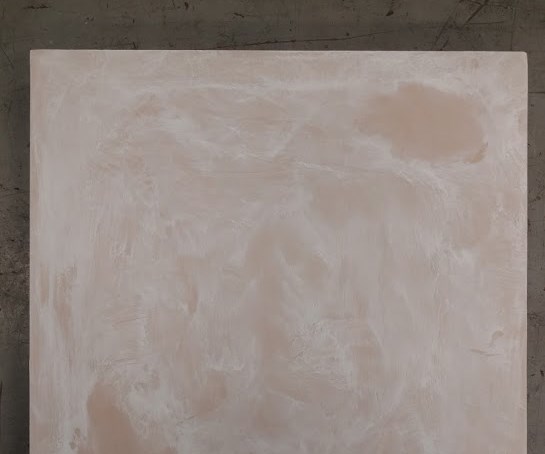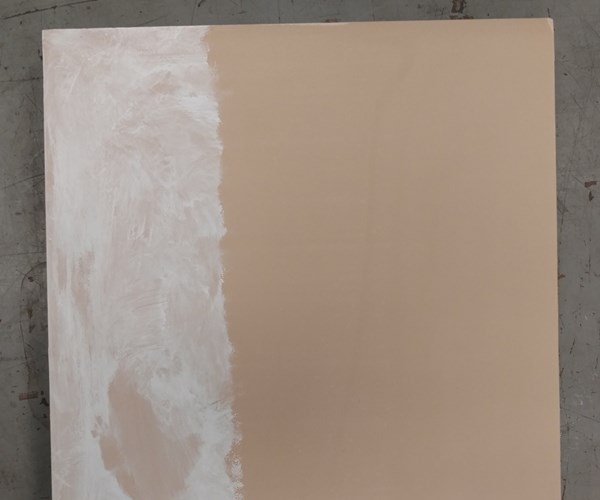Yes, you clean tooling board with dry ice
Coastal Enterprises and Cold Jet cooperate to assess the use of dry ice blasting to clean the contaminated surface of a high-density urethane tooling board material.

Dry ice blasting of Coastal Eneterprises tooling board.
Dry ice blasting is often used to clean metallic molds in composites fabrication operations, and it can do so without damaging the mold itself. Coastal Enterprises Co., however, wondered if dry ice blasting could be used to clean its Precision Board high-density urethane (HDU) tooling board material. Coastal worked with dry ice equipment supplier Cold Jet LLC to clean a PBLT70 tool coated with FSC88 WB Primer.
The results? Dry ice cleaning removed the primer and left the Precision Board HDU surface smooth and with no visible surface deterioration.
The test replicated cleaning contaminants off of a fouled mold without damaging the material, allowing for multiple cycles of cleaning and resealing of a Precision Board tool.

Tooling board before cleaning.
Dry ice blasting is similar in concept to sand or water blasting, but dry ice blasting uses non-abrasive media in the form of recycled CO2 pellets that will not damage surfaces. The combination of dry ice blasting’s kinetic energy and thermal effects break the connection between the contaminant and surface, lifting it away. Unlike blasting with other media, dry ice does not leave any secondary waste, because the dry ice particles sublimate upon impact – converting from solid to gas.

Tooling board after cleaning.
Dry ice cleaning can help meet strict industry demands by providing a composite tool cleaning solution that is fast, delicate and does not use chemicals or solvents. It is a nonabrasive cleaning solution that extends the life of molds and equipment by eliminating the need for harsh chemicals, wire brushes and coarse pads.
Tooling used for, but not limited to, compression molding, resin transfer molding, extrusion, prepregging and wetlayup are all said to be good applications for dry ice blast cleaning.
Testing was done on a sample of Precision Board PBLT70 partially coated with FSC88 WB Surface Primer. Cold Jet used the i3 MicroClean, with conventional block dry ice, MC88 nozzle, and 60 psi blast pressure.
According to Steve Wilson, director of global business development for Cold Jet, “The contaminant on this sample required a little less pressure than the uncoated sample of PBLT75 that we also tested, but could be dialed in to clean quite nicely.” While it cleaned a bit slower than the second sample, the process can be adapted for larger nozzles with the SDI Select60 machine from Cold Jet.
“The blast pressure is on the very low end of the process capabilities,” says Wilson. “There is plenty more cleaning capacity if needed. From visual, 400X photos and calibers, I can see no deterioration to the Precision Board sample surface. About two-thirds of it has been cleaned so that you can see the comparison between before and after. The surface of the part still feels very smooth.”
Testing on the second sample of Precision Board, PBLT75, with no coating, was also done with Cold Jet’s i3 MicroClean machine.
For more with Coastal Enterprises, check out Episode 14 of CW Talks: The Composites Podcast.
Related Content
Materials & Processes: Fabrication methods
There are numerous methods for fabricating composite components. Selection of a method for a particular part, therefore, will depend on the materials, the part design and end-use or application. Here's a guide to selection.
Read MoreNovel dry tape for liquid molded composites
MTorres seeks to enable next-gen aircraft and open new markets for composites with low-cost, high-permeability tapes and versatile, high-speed production lines.
Read MoreMaterials & Processes: Resin matrices for composites
The matrix binds the fiber reinforcement, gives the composite component its shape and determines its surface quality. A composite matrix may be a polymer, ceramic, metal or carbon. Here’s a guide to selection.
Read MoreOne-piece, one-shot, 17-meter wing spar for high-rate aircraft manufacture
GKN Aerospace has spent the last five years developing materials strategies and resin transfer molding (RTM) for an aircraft trailing edge wing spar for the Airbus Wing of Tomorrow program.
Read MoreRead Next
CW’s 2024 Top Shops survey offers new approach to benchmarking
Respondents that complete the survey by April 30, 2024, have the chance to be recognized as an honoree.
Read MoreFrom the CW Archives: The tale of the thermoplastic cryotank
In 2006, guest columnist Bob Hartunian related the story of his efforts two decades prior, while at McDonnell Douglas, to develop a thermoplastic composite crytank for hydrogen storage. He learned a lot of lessons.
Read MoreComposites end markets: Energy (2024)
Composites are used widely in oil/gas, wind and other renewable energy applications. Despite market challenges, growth potential and innovation for composites continue.
Read More

















.jpg;maxWidth=300;quality=90)








